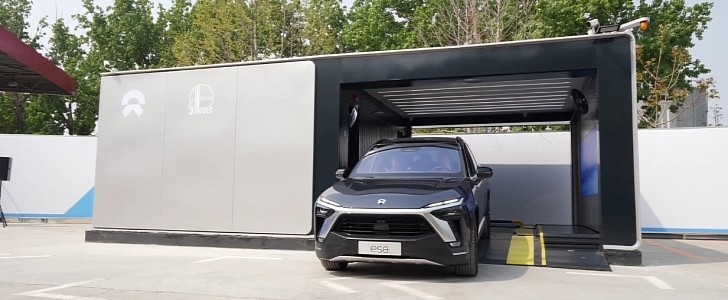Currently, most EV owners are recharging their vehicles at home, provided that they have access to a garage with electrical service, or at public EV charging stations. But with the increasing number of EVs, the shortage of parking spaces is becoming more and more prominent. That's why the way some people charge their cars might change in the future to battery swapping.
The Fluence Z.E. was the first modern electric car known to be enabled with battery swapping technology, but the idea of swapping batteries didn't quite take off at the time. Closer to our time, NIO, a Chinese EV manufacturer, is trying to popularize the concept, and it is hard at work doing it.
In May 2018, NIO opened its first battery swap station in Shenzhen, but only batteries for NIO ES8 cars are available from that station. Last year, the company announced the launch of its 100 kWh battery together with battery upgrade plans. In March 2021, it celebrated its 2.05 million battery swap at the Suzhou Delivery Center, China.
Now, a month later, NIO and Sinopec, a Chinese oil and gas enterprise, held a ceremony at Sinopec's Chaoying Station in Beijing, inaugurating NIO's second-generation battery swap station.
According to Sinopec, the station can provide up to 312 power replacement services in a single day, and a single power replacement lasts only 4 minutes and 30 seconds. The station includes features such as automatic parking and automatic exchange. It's a 60 square meters self-service station where users do not need to get off the car. The parking and the battery swap can be completed with a tap on a display and without getting out of the vehicle.
In addition to the new station, the two parties will also work together on new materials and smart EV technology, Battery-as-a-Service (BaaS), and vehicle acquisitions.
Yuzhuo Zhang, Sinopec's chairman, stated at the ceremony that "the company is accelerating its transition to an integrated energy service provider [...], and has the ambitious goal to reach 5,000 rechargeable power stations by 2025".
Sinopec (source is in Chinese) is not only distributing electricity. Currently, it is already one of the largest hydrogen energy suppliers in China, with an annual hydrogen production capacity of more than 3.5 million tons, accounting for about 14 percent of the country's total output.
In May 2018, NIO opened its first battery swap station in Shenzhen, but only batteries for NIO ES8 cars are available from that station. Last year, the company announced the launch of its 100 kWh battery together with battery upgrade plans. In March 2021, it celebrated its 2.05 million battery swap at the Suzhou Delivery Center, China.
Now, a month later, NIO and Sinopec, a Chinese oil and gas enterprise, held a ceremony at Sinopec's Chaoying Station in Beijing, inaugurating NIO's second-generation battery swap station.
According to Sinopec, the station can provide up to 312 power replacement services in a single day, and a single power replacement lasts only 4 minutes and 30 seconds. The station includes features such as automatic parking and automatic exchange. It's a 60 square meters self-service station where users do not need to get off the car. The parking and the battery swap can be completed with a tap on a display and without getting out of the vehicle.
In addition to the new station, the two parties will also work together on new materials and smart EV technology, Battery-as-a-Service (BaaS), and vehicle acquisitions.
Yuzhuo Zhang, Sinopec's chairman, stated at the ceremony that "the company is accelerating its transition to an integrated energy service provider [...], and has the ambitious goal to reach 5,000 rechargeable power stations by 2025".
Sinopec (source is in Chinese) is not only distributing electricity. Currently, it is already one of the largest hydrogen energy suppliers in China, with an annual hydrogen production capacity of more than 3.5 million tons, accounting for about 14 percent of the country's total output.

